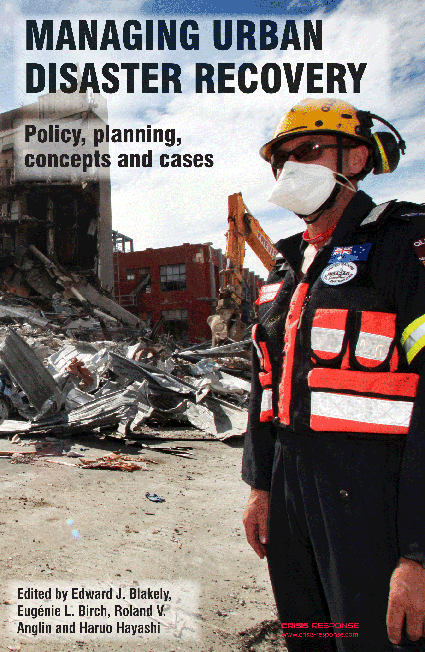Managing urban recovery: policy, planning, concepts and cases
Recovery after a major disaster is often overlooked - after the heroic rescues, the tales of human suffering and endurance, the statistically-impressive clean-up efforts, the media moves onto the next event, national and international attention dwindle and few pay attention to the arduous process of rebuilding infrastructure and communities.

Recovery requires a different type of management to that of first response, but often recovery efforts are
mismanaged, whether through lack of experience, awareness or because of political interference.
Theoretically, everyone understands the need for a 'successful' recovery after a disaster, but sometimes it appears that authorities may not have thought too deeply about how to achieve this goal before such an event takes place. The delineations between the phases are blurred and cross over, causing conflicts
between departments, authorities, legislators and, most importantly, the affected citizens.
The recovery phase presents different demands, needs different strategies and definitely requires a different type of vision.
The lead editor of Managing Urban Recovery: Policy, Planning, Concepts and Cases is Edward J Blakely who, together with 12 extremely distinguished experts from around the world, has compiled one of the most valuable resources for anyone who is likely to be involved in facing the aftermath of a disaster - whether they be practitioners, scholars or students. In fact, I would suggest that people living in areas prone to natural hazards would benefit from reading this book in order to understand the issues and pressures that might affect them when a disaster subsides and the response and recovery phases begin.
The book spans some of the world's largest catastrophes of recent years from the perspective of those directly involved in reconstruction and recovery; these disasters include the Kobe earthquake, Japan, the Indian Ocean tsunami, and Hurricane Katrina in the US.
The first of three sections examines managing recovery and describes common pitfalls, such as the desire to rebuilding exactly as before - essentially putting the same flawed infrastructure back into exactly the same vulnerable area in which it was located prior to the disaster. Ways of setting strategy, then translating this into specific planning - including guidelines for implementation and financing - are discussed in detail. The key personal and practical skills a successful recovery manager needs are also highlighted, as are how to harness the human and financial resources available to turn the manager's vision into practice.
Section Two considers the social, cultural and economic aspects of disaster recovery. While effective management of the recovery process is essential, no recovery will be successful if it fails to engage the public in equitable and meaningful ways. The challenge for recovery managers is how to achieve this goal, while still maintaining the momentum and efficiency of the recovery process. The chapters in this look at community engagement, how to maintain community ties among long-term evacuees and how to engage civic groups and volunteers. Communication - both good and bad - is examined in some detail, along with advice on how well-guided symbolism can help to restore a community.
Jed Horne says that the need to control information is equally important and here, a narrative examining the effects and media misinformation during Hurricane Katrina is fascinating: "The deluge of misinformation was built not just of rumours repeated often enough to gain the force of reportable fact, but also through exaggerated public statements passed on by city officials. The falsehoods undercut the emergency response in the storm's immediate aftermath," he says.
This is fascinating, especially when read in conjunction with Michael Brown's book Deadly Indifference (see CRJ 7:3).
The economic aspects of recovery are also covered: How do different funding resources shape the final recovery outcome? Should the existing economy be reinstated, or does the disaster provide an opportunity to pursue new economic development? What role should insurance and moral hazard play in the economic recovery process?
The final section considers the physical elements of recovery. Here, another recovery dilemma is discussed: How best to restore infrastructure and services as quickly as possible, while taking into account the need to build-in greater resilience against future disasters?
The section focuses on housing and the difficult issues of changing settlement patterns after a disaster, as well as rebuilding housing that is equitable and more sustainable. In addition, Fisher and Neuman examine the complexity of deciding what hard physical infrastructure should be rebuilt post-disaster, and to what scale: " Disasters change the size and shape of places, so there is a need to rethink what is required, where it is put, how it is built, and how it is interconnected. In this way, the recovery process will be able to both serve current needs, as well as take the right steps toward a resilient future," they say.
An extremely useful aspect of the book is the number of universally applicable illustrations and tools. Cases and resources at the end of each chapter illustrate the conceptual bases for the recovery process, as well as being excellent teaching materials for instructors. As the editors say: "We believe this approach is the best way to provide a book that can be used both as a reference text in the rapid-fire context of disaster recovery and as a catalyst for more conceptual analyses and discussions in the teaching/learning environment."
Professor Blakely has also recently published a short compilation of interviews, speeches, op-ed pieces and articles, completed between 2009 and 2011, which attempts to provide post-disaster policymakers with a set of guidelines, based on his experience. He is also writing a series of in-depth articles based around recovery, for Crisis Response Journal
-
Managing Urban Disasters, Edward J Blakely; Eugenie L Birch; Roland V Anglin; Haruo Hayashi; and with Laura Crommelin, is published by Crisis Response Publications, ISBN 978-0-9570710-0-1; available through Amazon or books@crisis-response.com